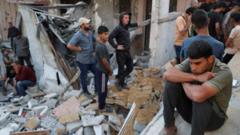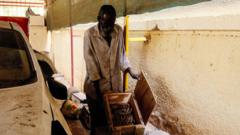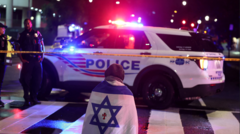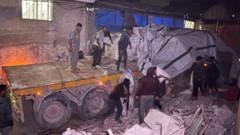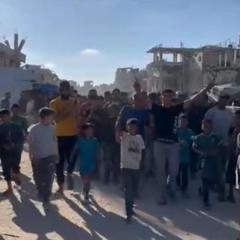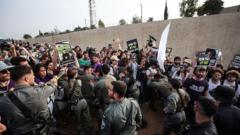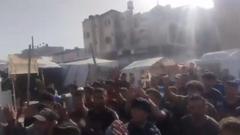The partial lifting of an Israeli blockade has led to chaotic food distribution in Gaza, where desperation and violence are on the rise. Armed looters attacked an aid convoy amid ongoing clashes, further complicating an already fragile humanitarian situation. Calls for a more efficient aid distribution method grow as the UN warns of impending famine for the 2.1 million residents.
Desperation Mounts in Gaza Amid Food Crisis and Escalating Violence
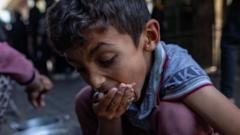
Desperation Mounts in Gaza Amid Food Crisis and Escalating Violence
As humanitarian aid trickles into Gaza, chaotic scenes erupt as residents grapple with starvation and lawlessness, highlighting the dire need for effective food distribution and security.
In Gaza, recent attempts to deliver humanitarian aid have resulted in chaos and violence, as limited food supplies lead to desperate measures among the population. Following a partial lifting of the Israeli blockade, which allowed around 130 aid trucks to enter in just three days, bakeries were overwhelmed by crowds seeking sustenance, forcing many to suspend operations due to safety concerns.
The precarious situation escalated further when armed looters attacked a World Food Programme (WFP) convoy transporting flour. Eyewitnesses report a brief firefight ensued between the thieves and Hamas security personnel, only for Israeli drones to engage the Hamas unit, resulting in casualties among their ranks. Hamas condemned the strike, calling it a "horrific massacre," while the Israeli Defense Forces (IDF) maintained the operation aimed to target those they labeled as terrorists involved with humanitarian supplies.
Despite the trickling of aid into Gaza—far below the 500 to 600 trucks per day that the UN states is necessary—widespread hunger remains, with many Gazans expressing frustration over the distribution methods employed. Some locals have called for the immediate distribution of flour instead of bread, arguing it would allow families to bake safely in their homes or temporary shelters, rather than waiting in crowded areas.
The Rada, a midwife working in the beleaguered region, describes harrowing conditions as women arrive at her clinic malnourished and unable to provide enough nourishment for their infants. Young residents of conflict-ridden areas share distressing accounts of evacuations ordered by the IDF, only to find they have nowhere else to flee, and contend with blasted infrastructure and a lack of basic needs.
International organizations like the UN and WFP have repeatedly urged for enhanced security measures to facilitate safe delivery of aid, which has become a growing source of anxiety and fear among the population. Advisors and analysts underscore that the massive backlog of aid waiting to be delivered greatly contrasts with the insufficient immediate supplies reaching Gaza's desperate residents.
As the humanitarian crisis deepens and calls for more effective solutions grow, the unfolding events in Gaza reveal a complex blend of desperation, conflict, and the dire human cost of warfare.
The precarious situation escalated further when armed looters attacked a World Food Programme (WFP) convoy transporting flour. Eyewitnesses report a brief firefight ensued between the thieves and Hamas security personnel, only for Israeli drones to engage the Hamas unit, resulting in casualties among their ranks. Hamas condemned the strike, calling it a "horrific massacre," while the Israeli Defense Forces (IDF) maintained the operation aimed to target those they labeled as terrorists involved with humanitarian supplies.
Despite the trickling of aid into Gaza—far below the 500 to 600 trucks per day that the UN states is necessary—widespread hunger remains, with many Gazans expressing frustration over the distribution methods employed. Some locals have called for the immediate distribution of flour instead of bread, arguing it would allow families to bake safely in their homes or temporary shelters, rather than waiting in crowded areas.
The Rada, a midwife working in the beleaguered region, describes harrowing conditions as women arrive at her clinic malnourished and unable to provide enough nourishment for their infants. Young residents of conflict-ridden areas share distressing accounts of evacuations ordered by the IDF, only to find they have nowhere else to flee, and contend with blasted infrastructure and a lack of basic needs.
International organizations like the UN and WFP have repeatedly urged for enhanced security measures to facilitate safe delivery of aid, which has become a growing source of anxiety and fear among the population. Advisors and analysts underscore that the massive backlog of aid waiting to be delivered greatly contrasts with the insufficient immediate supplies reaching Gaza's desperate residents.
As the humanitarian crisis deepens and calls for more effective solutions grow, the unfolding events in Gaza reveal a complex blend of desperation, conflict, and the dire human cost of warfare.

